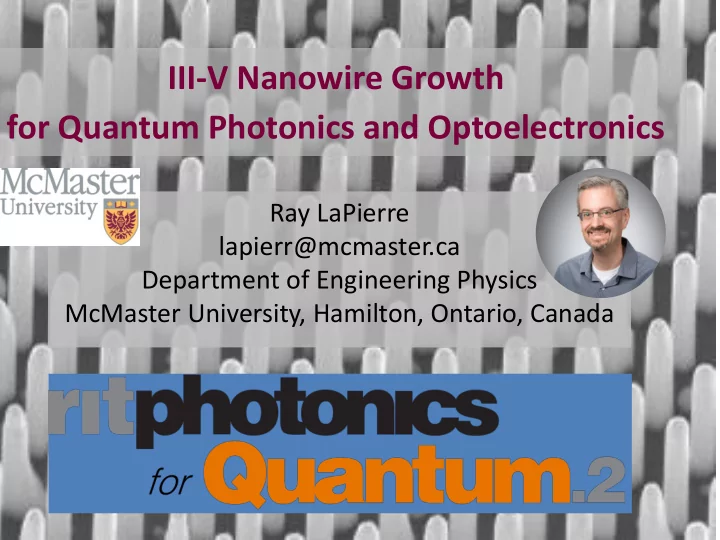

III-V Nanowire Growth for Quantum Photonics and Optoelectronics Ray LaPierre lapierr@mcmaster.ca Department of Engineering Physics McMaster University, Hamilton, Ontario, Canada
Semiconductor Nanowires 2D array of semiconductor rods III-V material: (In,Ga,Al)-(P,As,Sb) Single crystals Diameter ~ 10 – 500 nm Length ~ 1 – 10 m m 500 nm 1 m m 2 m m
The Role of III-V Nanowires in Quantum Information Science and Engineering • Majorana fermions Science 336 (2012) 1003 Nature Physics 8 (2012) 887 • Single photon sources & detectors Nat. Commun. 3 (2012) 737 Nat. Nanotech. 12 (2017) 1026 QIP (2020) 19, 44 Materials (2020) 13, 1400
Molecular Beam Epitaxy (MBE) substrate Sb In Ga Al gas cracker AsH 3 PH 3
Au-assisted Nanowire Growth Process Au deposition III-V deposition Diameter & length (MBE) dispersion III (Ga) V (As 2 ) Substrate Au droplet 500 nm
Self-assisted Selective-area Epitaxy Lithographic III-V deposition Controlled length, patterning (MBE) diameter, position, composition & doping D = 50-100 nm III (Ga) V (As 2 ) P = 360 – 1000 nm SiO 2 SiO 2 hole P D Si substrate III droplet 500 nm 500 nm
Example: GaP Nanowires J. Crystal Growth 462 (2017) 29
Group V Dependence Primary Flux III (Ga) V (P 2 ) SiO x Si J. Crystal Growth 462 (2017) 29
Pitch/Period Dependence GaP InSb GaAs J. Crystal Growth 462 (2017) 29 Nanotechnology 25 (2014) 415304 Nano Futures 1 (2017) 035001
Pitch Dependence III (Ga) V (P 2 ) III (Ga) V (P 2 ) SiO x Secondary Flux Si Nanotechnology 25 (2014) 415304
Droplet Dynamics: Diameter Control V/III flux ratio ~ 1 V/III flux ratio > 1 1 m m 1 m m Optical funnel/horn IEEE J. Photovolt. 9 (2019) 1225
Group III Dependence High temperature Low temperature Low V/III flux ratio High V/III flux ratio High III Low III adatom adatom diffusivity diffusivity Axial Radial growth growth Quantum Quantum Encapsulation, Core-shell wire dot passivation heterostructures
Opportunity 1: Unique Heterostructures Core-Shell Heterostructures Axial Heterostructures • Radial quantum wells • Quantum dots • Superlattices
Opportunity 2: Heterogeneous Growth on Si Thin Films Nanowires III-V zinc-blende crystal III-V structure Si Si diamond Dislocations Dislocation-free crystal structure PRB 74 (2006) 121302(R)
Integration with Si Photonics ACS Photonics 7 (2020) 1016 J. Appl. Phys. 125 (2019) 243102 Appl. Phys. Lett. 115 (2019) 213101 PSS RRL 13 (2019) 1800489 Nano Lett. 17 (2017) 5244 Nano Lett. 16 (2016) 1833 ACS Photonics 4 (2017) 2537
Challenge 1: Surface Passivation Au Au Ga Ga As As Al Al In In P P GaAs GaAs AlInP AlInP
Surface Passivation passivated unpassivated passivated unpassivated JAP 111 (2012) 094319 JAP 112 (2012) 063705 SST 28 (2013) 105026
Challenge 2: Doping Nanowire reconstruction by electron holography
Three-fold Symmetric Doping Mechanism Introduction Electron holography TEM Built-in Phase map potential truncated facet Nano Lett. 17 (2017) 5875
Putting It All Together: Nanowire p-i-n Structures p i passivation n n+ SiO 2 passivation n p-Si i p Physica Status Solidi RRL 7 (2013) 815 IEEE J. Photovoltaics 6 (2016) 661
Single Nanowire Devices Single Nanowire Device Fabrication (Quantum Computing) InAs quantum dot
Ensemble Nanowire Device Fabrication
Diode Characteristics Introduction IEEE J. Photovoltaics 6 (2016) 661
Opportunity 3: Diameter-dependent Optical Absorption Absorbed wavelength depends on nanowire diameter l 1 l 2 l 3 2 m m Nanotechnology 25 (2014) 305303
Nanowire Optical Resonant Modes • HE 1n radial waveguide modes • Increasing nanowire diameter → Red-shift of absorptance GaAs, Period: 400 nm, Length: 450 nm 1 60nm 0.9 100nm 125nm 0.8 150nm 175nm 0.7 200nm Reflectance 0.6 Absorptance 0.5 0.4 0.3 0.2 0.1 0 400 500 600 700 800 900 1000 Wavelength(nm) Nanotechnology 25 (2014) 305303
Nanowire Length Dependence GaAs nanowires, Period: 400 nm Length: 1000 nm Length: 450 nm Length: 2200 nm Photodetectors Photovoltaics Power Convertors Nanotechnology 25 (2014) 305303 J. Appl. Phys. 112 (2012) 104311
Thin Film Multispectral Photodetectors Military Night Vision Search & Rescue Biomedical Surveillance Manufacturing IR Astronomy JAP 105 (2009) 091101
Optical Satellite Communications • High Throughput and Secure Networks Challenge Program (HTSN) • Quantum Encryption and Science Satellite (QEYSSAT)
InSb Nanowires/Pillars D = 300 nm D = 500 nm D = 700 nm P = 2000 nm P = 2000 nm P = 2000 nm D = 900 nm D = 1100 nm D = 1300 nm P = 3000 nm P = 3000 nm P = 3500 nm 3 µm Semicond. Sci. Technol. 34 (2019) 035023
Mid-wavelength Infrared (MWIR) Multispectral Optical Absorption InSb Experiment Simulation Semicond. Sci. Technol. 34 (2019) 035023
Long Wavelength Infrared (LWIR) Multispectral Optical Absorption InAs 0.36 Sb 0.64
Multispectral Nanowire Growth III (Ga) V (P 2 ) III (Ga) V (P 2 ) SiO x Secondary Flux Si InSb: P = 1000 nm P = 1500 nm P = 2000 nm P = 3000 nm D = 440 nm D = 475 nm D = 505 nm D = 520 nm Increasing period → increasing diameter Nano Futures 1 (2017) 035001
Increasing period → increasing diameter → Red-shift of absorptance InSb Nano Futures 1 (2017) 035001
Quantum Dot (QD) Growth Mechanisms F 1 Direct Diffusion impingement L 1/D L L F 1 D D Desorption Droplet L F 2 purging F 2 Pitch L D L D
InAs x P 1-x QDs / InP Droplet Au purging L D InP 17.5 InAs 12.5 7.5 5 0 20 nm Nanotechnology 26 (2015) 315202
GaAs QDs / GaP 1 m m 100 nm Nanotechnology 29 (2018) 124003
GaAs/GaP QD Photodetectors i-GaP n-GaP p-GaP E C i-GaAs QD p-Si ITO E F E V Nanotechnology 29 (2018) 124003
Summary • Small pixel size (single nanowire) • Excellent light coupling • High responsivity (better than thin films) • Multispectral: Visible to LWIR • Unique heterostructures • Monolithic integration with Si
Acknowledgements CEDT Centre for Emerging Device Technologies Toronto Nanofabrication Centre • Paige Wilson, Ph.D. • Amanda Thomas, M.A.Sc. • Ara Ghusakan, Ph.D. • Curtis Goosney, M.A.Sc. • Nebile Isik, Research Engineer
Recommend
More recommend